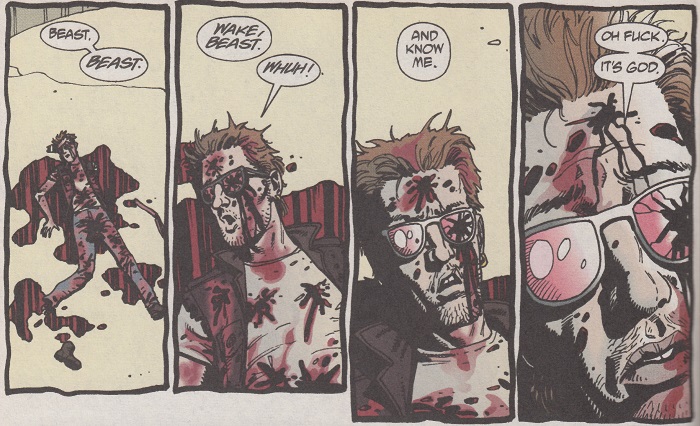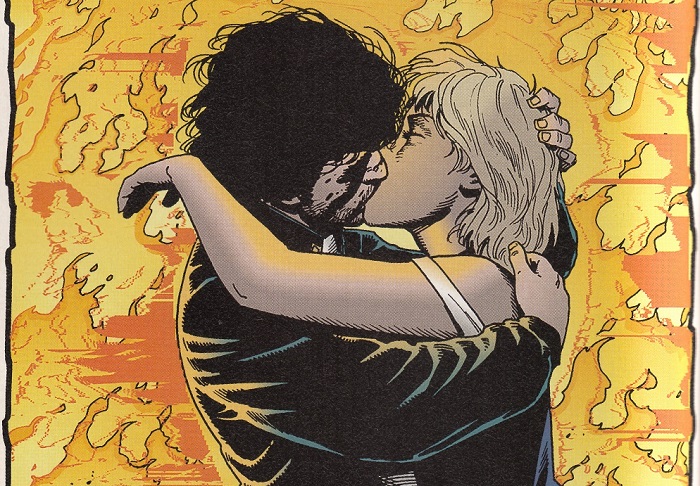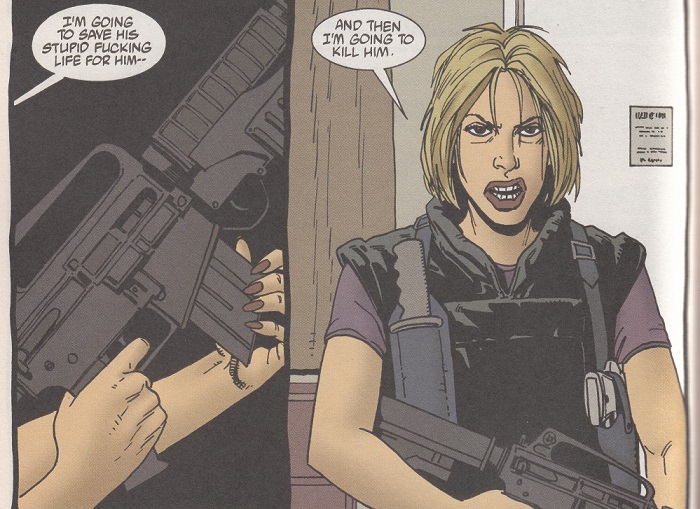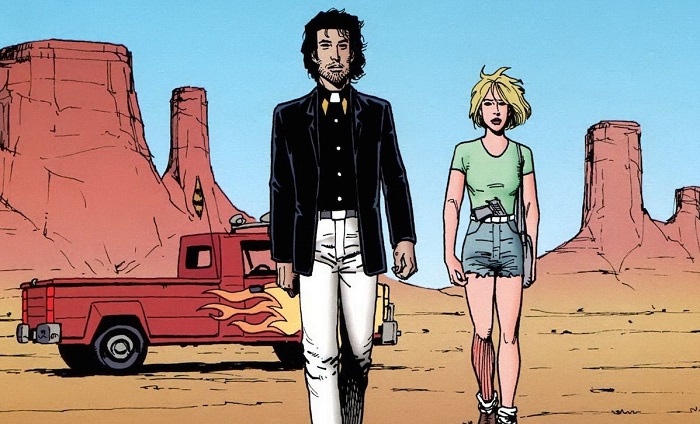This Sunday, Garth Ennis and Steve Dillon’s epic graphic novel series Preacher finally makes its way onto the small screen, and for many viewers it’s going to be their first (and only) iteration. For the rest of us, we’re going into the television show knowing that it doesn’t matter how great it is—it’ll pale in comparison to the graphic novels.
For those not in the know, Preacher was created by writer Garth Ennis and artist Steve Dillon, with Glenn Fabry on the original covers. The series was published by Vertigo and ran from 1995 to 2000. Since then it’s generally occupied a spot in every “Best Graphic Novels” list, and for good reason. Ennis and Dillon cover a lot of territory and use a variety of styles, tones, and genres to tell their story but always make sure to keep the dark humor and biting sarcasm at the fore.
Ostensibly it’s about Jesse Custer, a drunken twentysomething preacher in the backend of Texas who is possessed by a spiritual entity more powerful than God. He soon sucks into his orbit Tulip, his on and off girlfriend, former car thief, and one-time hitwoman turned modern day Calamity Jane, and Cassidy, the drugged up, drunken Irish vampire and backstabbing BFF. As Jesse, Tulip, and Cass set off on a quest to confront God for abandoning his creations, Jesse gets tangled up in the terrifying force of will that are his wicked relations, a global religious conspiracy spearheaded by The Grail and the sadistic Herr Starr, and a gaggle of onlookers, stragglers, and sundry minor characters who push the story in directions not even our trio can predict.
It’s also surprisingly forward thinking for a bloody indie comic from the 1990s. Racists, sexists, and homophobes abound, but all of them are Big Bads that Jesse, Tulip, and Cass eagerly destroy. Jesse and Tulip regularly engage in debates about feminism wherein he listens to her plight and learns from his mistakes without #NotAllMen-ing or mansplaining. He may be from a deeply racist corner of Texas but Jesse holds to heart his father’s words of wisdom about judging people not by how they look but how they behave. (That being said, the ableism, fat shaming, and mocking of the developmentally disabled utilized by the stars and creators is cringe-worthy.)

The series starts out as an ol’ fashioned tale of good versus evil run through a Western grinder. It’s Stagecoach but with angels, vampires, and inbreeding. Jesse’s past drags him back to hell on earth and suddenly it’s a story about free will and destiny. Then a sharp left to the Vietnam War and the experiences suffered by Jesse’s father, John, and his best friend, Spaceman, and we’re in the realm of politics and patriotism and how the two states often contradict each other. Cassidy recounts his candy coated autobiography along with a rapid descent into the abyss of the Saint of Killers’ origin story and suddenly Preacher becomes a tale about how we want to be seen by those we love. Arseface, Hoover, Quincannon, and Starr reveal unique facets of revenge and redemption. Jesse and Tulip’s relationship post-France—and especially the arc about Tulip’s childhood—is all intersectional feminism, gender equality, and cultural respect but still manages to attack far left liberalism and far right conservatism with equal abandon. And the whole thing ends up a damn cowboy story once more.
No matter how gross-out or violent the story gets, at the heart of it Preacher is a love story. Sure, story-wise every topic under the sun gets its time to shine, but above all that are Arsefaced cupids with taut bowstrings ready to strike witting and unwitting couples alike. Love can be unrequited and foolish, dangerous and fragile, simple and welcomed, complicated and contented, misunderstood and fractured. Everyone wants love in Preacher, but most of them go about acquiring it in the most bone-headed ways possible.

This ain’t some starry-eyed 90s rom-com kinda “love.” This is real world love, love you have to work at, love that can make you a new person but not necessarily a better one. Jesse Custer and Tulip O’Hare have a love for the ages, a grand, Homeric tale of forgiveness, acceptance, and change that sprawls years and countries and deaths and resurrections. Yet even the platonic love front gets its strikes in. Jesse and Cassidy have a bond forged in battle but it’s too weak to stand up to Cass’ insecurities and moral failings, and still his final act is one born of a love too great to name. Tulip and Amy share a similar love but theirs is tempered only by time and distance, not competition or male bravado.
For Preacher love is the end, but violence of word, tone, and action is the means. Blood, nudity, cruelty, and derogatory terms stain nearly every page, yet even when the chaos veers toward gratuitous it always has a thematic point. Remember, Preacher is first and foremost a Western, and Westerns are romantic in both senses of the word. Love permeates Western tales. The love of a good woman can turn an evil man into a saint, and the loss of her can drive a decent man to savagery. A relationship between a man and his horse or a man and his partner is sacred, unbreakable, and worthy of revenge when stolen.
On the other side of the saddle is the mythology of the West. There’s a reason the word, the region, the idea itself is capitalized. The West is a place where myth and legend mingle with hard truths and mean realities. John Wayne and Louis L’Amour are the idealized end of the mythical West, with Unforgiven and Deadwood on the bloodsoaked extreme. But what they all have in common is the understanding that heroes never fret over doing good or bad. It’s doing what’s right that matters, even if balancing the scales means killing. Jesse confronts this truth with his own two opposites: the Saint of Killers and his hallucinatory John Wayne. The Saint damned himself and let his hate eat him alive while the Duke guides Jesse along the path of cowboy justice. Jesse wants God to atone for his crimes against humanity but isn’t above meting out his own justice against those who cross him or those he cares about. It’s the cowboy way. Hell, it’s the American way.

So yeah. In case I haven’t made it clear, Preacher is one helluva comic book. I’ve consumed it half a dozen times since I first stumbled upon it about a decade ago, and each time it gets better and better. Sure, it struggles now and then with a bloated, meandering plot. Sometimes the cast of characters gets a little too ungainly. It’s rife with curse words and inflammatory terms of the most racist, sexist, homophobic kind. And YMMV on the finale. (Frankly, I thought it was absolutely perfect, I mean, it’s a freaking Western for Hera’s sake. How could it have ended any other way?)
And yet. Preacher is a punch to the gut, a kick in the ass, heart-rending, teeth-grinding, mind-bending series that starts out dark and somehow gets even worse. It’s a powerful series with layers like a rotten onion—each one gets you closer to the truth but process gets messier the deeper you go.
Alex Brown is an archivist, research librarian, writer, geeknerdloserweirdo, and all-around pop culture obsessive who watches entirely too much TV. Keep up with her every move on Twitter and Instagram, or get lost in the rabbit warren of ships and fandoms on her Tumblr.










